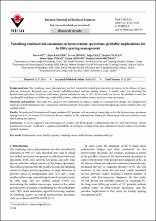| dc.contributor.author | Öz, Murat | |
| dc.contributor.author | Karalök, Alper | |
| dc.contributor.author | Şirvan, Levent | |
| dc.contributor.author | Taşçı, Tolga | |
| dc.contributor.author | Öcalan, Reyhan | |
| dc.contributor.author | Turan, Ahmet Taner | |
| dc.contributor.author | Güngör, Tayfun | |
| dc.contributor.author | Meydanlı, Mehmet Mutlu | |
| dc.date.accessioned | 2019-05-13T09:02:45Z | |
| dc.date.available | 2019-05-13T09:02:45Z | |
| dc.date.issued | 2017 | |
| dc.identifier.citation | Öz, M., Karalök, A., Şirvan, L., Taşçı, T., Öcalan, R., Turan, A. T., Güngör, T., Meydanlı, M. M. (2017). Vanishing endometrial carcinoma in hysterectomy specimens: Probable implications for fertility sparing management. Turkish Journal of Medical Sciences, 47(6), 1744-1750. | en_US |
| dc.identifier.issn | 1300-0144 | |
| dc.identifier.uri | https://doi.org/10.3906/sag-1607-93 | |
| dc.identifier.uri | https://hdl.handle.net/11491/1323 | |
| dc.description.abstract | Background/aim: The vanishing cancer phenomenon was first reported in radical prostatectomy specimens in the absence of neoadjuvant treatment. Reported cases are mostly well-differentiated and low-volume tumors. A similar entity was described for hysterectomy specimens of patients with biopsy proven endometrial cancer (EC). In this study, we discuss the probable reasons for vanishing EC and long-term follow-up results of EC patients without residual tumors in hysterectomy specimens. Materials and methods: This study was carried at two institutions in Ankara, Turkey, in a retrospective design. The computerized databases of both institutions were searched for endometrioid type EC patients whose final pathological specimens failed to show any residual tumor. Results: We evaluated 38 endometrial biopsy confirmed EC patients with no residual tumor detected in the hysterectomy specimens among a total of 224 women (17%) with the disease confined to the endometrium. During the follow-up period, no recurrences were noted among the patients. Conclusion: It can be suggested that premenopausal women with FIGO grade 1 endometrioid type EC with MRI proven “absent myometrial invasion” would have a significant probability of having no residual tumor after endometrial biopsy without any further medical treatment. © TÜBİTAK. | en_US |
| dc.language.iso | eng | |
| dc.publisher | TUBİTAK | en_US |
| dc.relation.isversionof | 10.3906/sag-1607-93 | en_US |
| dc.rights | info:eu-repo/semantics/openAccess | en_US |
| dc.subject | Endometrial Cancer | en_US |
| dc.subject | Endometrioid Type | en_US |
| dc.subject | Fertility Sparing | en_US |
| dc.subject | Residual Tumor | en_US |
| dc.subject | Vanishing Cancer | en_US |
| dc.title | Vanishing endometrial carcinoma in hysterectomy specimens: Probable implications for fertility sparing management | en_US |
| dc.type | article | en_US |
| dc.relation.journal | Turkish Journal of Medical Sciences | en_US |
| dc.department | Hitit Üniversitesi, Tıp Fakültesi, Cerrahi Tıp Bilimleri Bölümü | en_US |
| dc.identifier.volume | 47 | en_US |
| dc.identifier.issue | 6 | en_US |
| dc.identifier.startpage | 1744 | en_US |
| dc.identifier.endpage | 1750 | en_US |
| dc.relation.publicationcategory | Makale - Uluslararası Hakemli Dergi - Kurum Öğretim Elemanı | en_US |


















